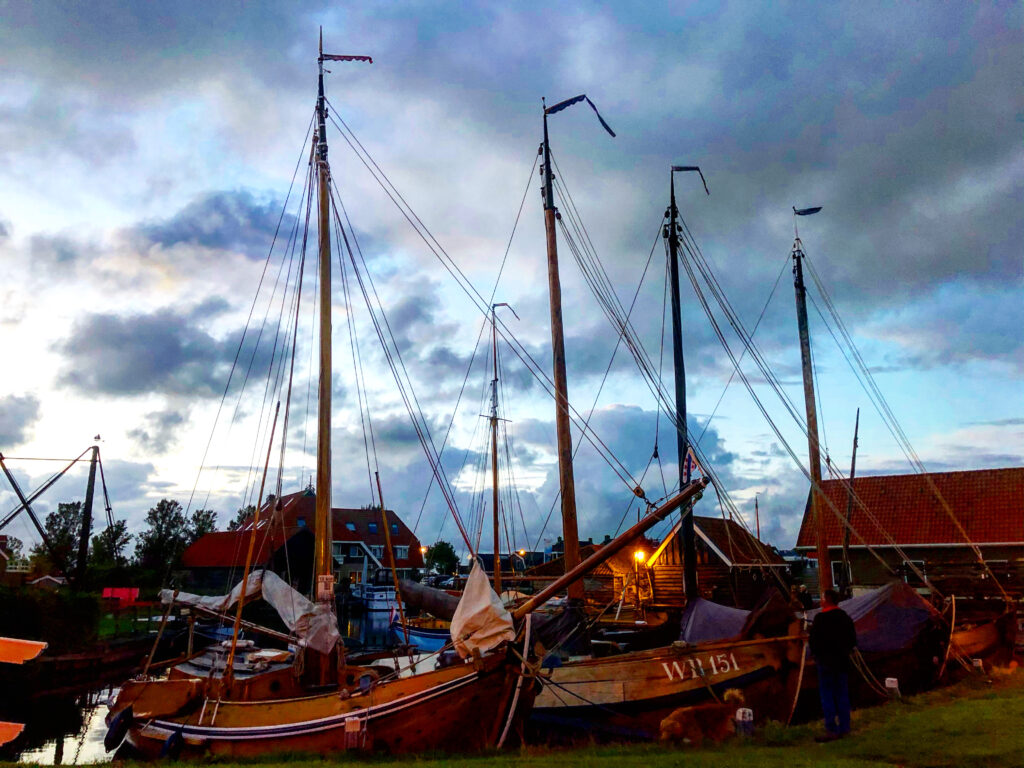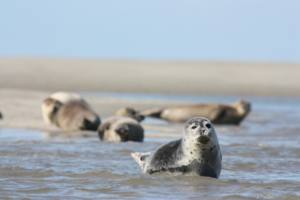Visit the ports on the Dutch Wadden Islands
Whether you are an adventurer looking for excitement and thrills, a nature lover looking to enjoy the peace and beauty of nature, or just someone looking for a relaxing holiday by the sea, the Dutch islands and their Wadden ports have something for everyone.
The history of the Wadden harbours
The Wadden ports have a rich and fascinating history dating back centuries. These ports served as important hubs for trade and shipping, and have had a major impact on the region’s development. Below, we dive deeper into the history of the Wadden ports and how they have developed over time.
1. Early settlements and trade
The history of the Wadden ports starts with early settlements along the coast. The location of the Wadden Islands made them favourable places for trade and exchange of goods. Ships from different parts of Europe docked at the ports to trade their goods. This trade brought prosperity and growth, and the ports soon became important economic centres.
2. The Texel Reede
The Reede van Texel, once a glorious scene from the 15th century. A place where ships gathered after a voyage from places along the Zuiderzee. They anchored themselves at the Texel Reede, ready to raise their sails in favourable winds and set sail for places like Amsterdam all the way to the exotic East Indies. It was a spectacle that filled the 17th and 18th centuries with blistering activity. A lively hodgepodge of sailors, traders and adventurers thronged this glorious place.
3. Thriving during the Golden Age
During the Golden Age, between the 17th and 18th centuries, the Wadden harbours experienced their peak. At that time, the Netherlands was a world power in trade and shipping, and the Wadden harbours played a crucial role in this booming industry. Ships from all corners of the world came to the ports to load and unload goods. Cities such as Harlingen and Delfzijl grew into important trade centres and the ports became increasingly busy.
4. Modernisation and changes
Over time, the development of technology and infrastructure changed the Wadden ports. The arrival of steamships and later the modernisation of shipping brought new challenges. Ports had to adapt to the changing needs and demands of the shipping industry. New facilities were built and ports were modernised to efficiently handle growing trade flows.
5. Ports as tourist destinations
Today, Wadden ports are important not only for trade and shipping, but also for tourism. Many people visit the ports to enjoy the beautiful coastline, the unique nature and the charm of the islands. The ports also offer various recreational activities, such as boating, fishing and walking along the quayside. The combination of historical heritage, beautiful landscapes and lively maritime atmosphere makes the Wadden ports a surprising and unforgettable destination.
Best ideas for visiting Wadden Sea ports
If you are planning to visit the ports on the Wadden Sea, there are plenty of great ideas to make your experience unforgettable. Here are some suggestions to get the most out of your visit:
1. Discover the charm of fishing ports
The fishing ports on the Wadden Islands have a unique atmosphere and offer a glimpse into the lives of local fishermen. Stroll along the quays, admire the colourful boats and discover the rich traditions and history of fishing. Also be sure to try a freshly caught fish at the local fish stall or in one of the local restaurants.
2. Take a sailing trip along the Wadden Islands
A sailing trip is a great way to experience the beauty of the Wadden Sea and its surrounding islands. Sail along the coastline, enjoy the views of the sea and explore remote spots that can only be reached by flatbottom-ship. Various types of sailing trips are offered, from relaxed multi-day all-inclusive sailing holidays to adventurous day excursions.
3. Visit historic sights
Harbours on the Wadden Islands are often surrounded by historical sights. Visit old lighthouses, forts and other maritime monuments that bear witness to the region’s rich past. These places offer a fascinating insight into the history and culture of the Wadden ports.
4. Enjoy the natural beauty
The Wadden Sea and the surrounding nature reserves offer breathtaking natural beauty. Take a walk along the beaches, explore the dunes and spot birds and other animals in their natural habitat. The Wadden Islands are known for their diverse flora and fauna, and a visit to the harbours is a great opportunity to enjoy this.
The history of the lie bench in fishing ports
The lie bench is an intriguing feature of fishing ports in the Wadden Islands. But what is the history behind this particular phenomenon. It is a place where fishermen meet after a day at sea and where bold stories are told. The bench symbolises the strong community bond and rich culture of fishing ports. In the days when fishermen spent long periods at sea and had little contact with the outside world. When they returned to the port, the bench was where they gathered to catch up. It became a tradition to share stories and sometimes go a little overboard about the catches and adventures at sea.
Today, you can still find lie benches in fishing ports on the Wadden Islands such as Ameland. They serve not only as a meeting place for fishermen, but also as a symbol of community and tradition. It is a place where stories are woven and where the lively history of fishing ports comes alive.
What is there to see and do in the ports of the Wadden Islands?
The ports of the Wadden Islands offer a range of activities and attractions. Whether you are interested in maritime history, natural beauty or just want to enjoy the atmosphere of the islands, there is something for everyone. Here are some highlights of what you can see and do in the ports:
1. Enjoy fresh seafood
If you are a seafood lover, the ports of the Wadden Islands are the place to be. Many restaurants near the harbours serve delicious fresh fish dishes prepared with local ingredients. Try fresh shrimps, oysters or cod, for example, and enjoy the taste of the sea.
2. Explore the nature reserves
The Wadden Islands are known for their beautiful natural landscapes. Near the ports, you can often take walks through dune areas, beaches and nature reserves. Enjoy the fresh air, observe birds and other animals and take beautiful photos of the pristine nature around you.
3. Take part in water sports activities
The Wadden Sea offers plenty of opportunities for water sports enthusiasts. Rent a kayak or paddle board and explore the coastline at your own pace. You can also take part in organised activities such as sailing, windsurfing or fishing. Experience the excitement of being on the water and enjoy the amazing, natural beauty around you.
4. Take a boat trip to the seals
Many ports organise boat trips to the sandbanks where seals like to hang out. Hop on board and sail to these special places where you can admire these cute animals up close. It is a unique experience to come face to face with seals in their natural habitat.
5. Explore local shops and crafts
Around the ports you will often find charming shops and craft markets where you can buy local products and souvenirs. Browse the boutiques, discover handmade products and take home a piece of the Wadden Islands.
These are just some of the many opportunities offered by the ports in the Wadden Islands. Whether you are interested in history, nature, culinary experiences or adventure activities, you are sure to find something to enjoy during your visit to the Wadden ports.
FAQ (frequently asked questions)
1. Can I reach the ports on the Wadden Islands by car?
Yes, most Wadden Islands ports can be reached by car. There are ferry services connecting the mainland to the islands, and on the islands themselves you can usually drive around by car.
2. Are the Wadden ports open all year round?
Yes, most ports are open all year round. However, activities and opening hours may vary depending on the season. It is advisable to check the specific information and opening hours before visiting.
3. Can I book boat trips at the ports?
Yes, many ports offer boat trips that you can book. There are different types of boat trips available, ranging from short cruises to adventurous excursions. Check with local tourist information or port authorities for more information and booking options.
4. Are the ports wheelchair accessible?
The accessibility of ports can vary. Some ports have facilities and amenities for wheelchair users, while others may have limited access due to infrastructure. Please contact the relevant port authorities for specific information.
5. Which Wadden Islands have ports?
All of the Wadden Islands have harbours where boats can dock. Some of the best-known Wadden Islands with harbours are Texel, Terschelling, Vlieland, Ameland and Schiermonnikoog.
6. Is accommodation available near the harbours?
Yes, various accommodation options are often available near the ports, including hotels, bed & breakfasts, holiday homes and campsites. It is advisable to book in advance, especially during busy periods.
7. Are dogs allowed in ports and on boat trips?
The rules regarding pets may vary, so it is advisable to contact the port authorities or the boat trip provider for specific information on bringing pets.
8. Do I have to pay entrance fees to visit the ports?
There is usually no entrance fee to enter the ports themselves. However, some attractions, such as maritime museums or boat tours, may have an entrance fee. Check with the relevant venues for current prices.
9. Can I participate in fishing activities at ports?
Some ports offer the opportunity to participate in fishing activities, such as going along on a fishing boat or experiencing fishing yourself. Check with local fishermen or tourist information centres for available options.
10. Should I consider tides and tidal differences when visiting the ports?
Yes, the Wadden Sea is known for its tidal differences. It is advisable to consult tide information and take tides into account when planning your visit, especially for boat trips and water-based activities.



